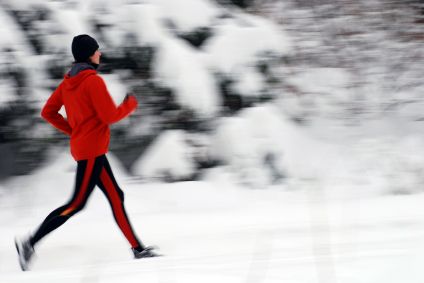01 Dec Cold-weather running tips to brighten your winter

While many fitness enthusiasts succumb to the elements and move their running primarily indoors to a treadmill, it doesn’t have to be that way. It’s possible to not only endure running outside in the winter, but actually to enjoy it.
Cold temperatures and snow have already hit much of the U.S. and we all know Mother Nature’s fury will continue in spurts until the spring.
While many fitness enthusiasts succumb to the elements and move their running primarily indoors to a treadmill, it doesn’t have to be that way. It’s possible to not only endure running outside in the winter, but actually to enjoy it.
Here are some tips Ohio distance runner and coach Jason Burgett offered on cold-weather running:
Realize importance of winter running — If you are a runner training for a spring race, or scholastic runner it’s important to get outside as much as you can to vary the training.
“For high school or college runners preparing for outdoor track season, winter running is crucial to fitness and peak performance in May,” Burgett said.
Dress the part — Seemingly everything is more high tech these days and that includes the way runners dress for the elements. Experienced runners don’t wear cotton long johns under cotton sweatpants anymore which when soaked in sweat can freeze and offer almost no insulation.
“With new, moisture-wicking materials comes the relief of moving the sweat away from the body (which is how we cool down, of course) and to the outer layers of the material, where it can’t touch the skin,” Burgett said. “But don’t overdress. Wearing too much actually can work against you. If you sweat too much, and the materials saturate, you’re left with a wet body on a cold day, perhaps miles and miles from home.
“This is not a good situation. I tend to dress for 10-20 degrees warmer, because I know I’m going to warm up a good bit, and then try to avoid the wind for the first few miles to help guard against the inevitable chill.”
Burgett also has learned to apply a small amount of lotion or sunscreen with petrolatum or lanolin to create a barrier to the elements and retain what little moisture remains in his face and fingers.
Lift your spirit — Snowy winter days are often gray and dreary and that can affect our mood as well. Getting outside can provide a ray of sunshine for people.
“Running helps to offset that dispiriting lack of sunshine by increasing the flow of endorphins through the body, which boosts the spirit,” Burgett said. “You can also boost your spirit, and your chances of being visible in the gray winter, by wearing super bright clothing on your runs.
“Not getting sideswiped is as much about you making yourself visible as it is about drivers giving you space. In other words, if you’re dull, don’t be surprised if drivers can’t see you.”
Plan your route — Running in the winter does provide unique challenges and it’s important to plan your route and also be ready for the unexpected.
“In winter, I usually run on the road more than the sidewalk, because so many sidewalks are not cleared, making it difficult for pedestrians,” Burgett said.
Interestingly, Burgett knows that not al people are supportive of having to slow down or swerve for runners, so he goes the extra step to thank them for their patience.
“When I’m running on the road, I try to give a friendly wave to every car that comes past, in the hopes that a little friendliness calms the drivers who may be bothered with me running on the side of the road,” he said.
Vary your training — Not everyone is able to breathe with the same efficiency in freezing temperatures.
“It’s true that the cold affects how easily a runner breathes, and many people suffer from exercise-induced asthma (EIA) which is exacerbated by cold weather,” Burgett said. “The cold air constricts the airways, and makes the runner feel like she’s suffocating.”
If you experience EIA, the run indoors on the treadmill, or at the local indoor track, if you find the temperatures too tough to deal with.
It’s also can be beneficial to cross train by doing things such as swimming indoors, taking a spin class or cross-training.
Burgett also reminds people of other fun ways to stay n shape in the winter, such as sledding and skiing.
At Home Fitness consultant Aaron Dorksen’s blog deals with a variety of fitness topics, ranging from workout tips, motivational ideas and feature stories on how exercise impacts people’s lives. E-mail him with comments, questions or ideas for future blogs at aaron@athomefitness.com

